Commonly Used Printable Documents
They might look goofy on the screen but tapping the image on mobile or looking below the image on desktop is a clear copy for you to download or print.
Online Forms
These will open a new page with the form embedded.
If you know what you want to find, but aren’t sure where it is, use the search option. You can also access the Google Drive and search.
We have basic instructions for how to do a lot of what we ask of you on this page. Review it and ask your mentor if you still need help.
How to:
Weigh an Animal
This is taken from the Colorado Animal Rescue. A video is posted there from the Kitten Lady to help you understand more.
Here are the basics:
Weigh them at approximately the same time each day and before you serve them a meal if at all possible.
Record the weights on the weight tracking forms we have for you (see the printable documents at the top of this page).
Why weigh kittens?
“Kittens are fragile little creatures, and can go “downhill” very quickly. Keeping an eye on their weight daily is crucial in monitoring their overall health. A healthy kitten should gain a minimum of 10 grams/0.3oz (or more) per day. If your kitten/s are losing weight, or failing to gain weight, it could be a sign of illness that needs to be addressed right away.”
**If your kitten/s are losing weight, or failing to gain weight, please notify us right away using your Facebook Med Chat.**
How to weigh kittens
“Kittens are little wiggle worms! It can be nearly impossible to get an accurate weight without some additional tools and a couple of tips. Don’t try to set your kitten directly on the scale. Instead:
- Grab a small cardboard box, or a small-medium size bowl (something big enough to place the kitten and a blanket/small towel in)
- Grab a small baby blanket or hand towel to wrap the kitten in
- While the scale is off, place the blanket inside the bowl and place the bowl on the scale
- Turn the scale on. Your scale should read zero. This is how you Tare a scale.
- You can now take the blanket out of the bowl (the scale will give you a negative weight reading), wrap up your first kitten, and place the kitten in the bowl.
If the kitten is still struggling and the weight is bouncing around, try re-wrapping the kitten and trying again. Sometimes you have to wait a few seconds for the kitten to stop moving to get the most accurate weight possible. An alternative to using. box/bowl and a towel is to place the kitten in a paper lunch bag while you are weighing. Just be sure to tare (set the scale to zero with the non kitten item on it) the bag using the same instructions as above!”
Kitten Lady video linked through Colorado Animal Rescue: https://www.coloradoanimalrescue.org/weighing-kittens/
Take a Temp
Lubricate the thermometer with petroleum or olive oil.
Turn it on.
Insert rectally until it is through the tight entrance and is a bit into the rectum. The distance depends on the age of the animal. Smaller animals need less inserted.
Wait until it beeps (10-60 seconds)
Remove, record temp.
Wipe clean with a disinfecting wipe or soap and water.
This video will walk you through all of it. https://youtu.be/14FEMIvXf78
Dusty has opinions about where you’ll need to put the thermometer, but he’ll forgive you eventually!

Trim Claws
The easiest clippers to use are shaped like scissors.
Place the cat on your lap with their back against your stomach and their feet facing away.
Grab the paw closest to your dominant hand with your non-dominant hand.
Gently push the claw out by pressing on the toe with your finger and your thumb.
Use your dominant hand to clip the claw just where the nail turns from opaque to transparent.
Transparent nails are like the white tips of human nails and the opaque parts are the nail bed.
Move to the other paw when all 5 claws are trimmed on the first paw.
Do the back feet last, in the same dominant/non-dominant order.
Give the cat a treat.
For dogs, keep them on their own feet and follow the same steps. Have an assistant distract the dog with a treat that takes a long time to eat.
Schedule Vaccines
See Medical Tracking form for details on vaccines. Core vaccines are FVRCP for cats and DHPP for dogs.
Vaccines need to be given every 2-3 weeks, up to a maximum of 4 vaccines. The final one should be given after 16 weeks old. You may need to pause after 3 vaccines to wait for the 16 week mark. The first one can be given as soon as 6 weeks old.
You can see that this would seriously tie up clinic appointments if everyone only got their vaccines at clinic.
Fosters all over town are trained to give core vaccines (not rabies vaccines). Use the Map of Fosters or chat with your mentor to find someone near you who can do the vaccines for you. Often this person can insert a microchip as well.
If you’re at clinic for testing or exam and you’re due for a vaccine, it’s fine to get it at clinic. You can even be trained to do it if you want at that appointment.
Try to use our trained fosters to get the majority of your vaccines outside of clinic please.
Deworm
While the document above has details for exactly how to deworm, you might wonder why we do it or need some tips.
We assume all animals come in with parasites. It is easier and cheaper to treat preventatively than deal with sick animals when it all goes wrong.
Pyrantel and Toltrazuril are used on young animals. Since we have time before they’re adopted and they are more vulnerable to infections causing serious harm, we take a two-pronged approach to kill any parasites. Pyrantel is given as early as 4 weeks and always exactly 14 days apart to kill the parasite at all of its life stages. Then, when the animal is older and stronger, we give Toltrazuril for 3 consecutive days.
They don’t like “tolt” as we call it, so if you can ensure they get a full individual dose, you can give it in a NEW food. For instance, take one kitten into the bathroom and give her a small plate with a spoonful of a new smelly food and mix in her dose of tolt. Wait for her to eat it and then repeat with the next kitten. All of the plated food must be consumed in one short session and by one animal only if you do it this way. Using a new food masks the scent of the medicine better than a food they are familiar with.
If you choose to administer tolt directly, it’s common for them to foam at the mouth. Aim for the back of the mouth and have a treat ready to make it up to them.
Panacur is given to older animals. This allows them to go to the cafe or the center and not spread any parasites. It is given for 5 consecutive days and it is usually well tolerated, but you can use the same food trick from above if you can ensure they consume the entire dose in one short session.
If you have any questions, please contact your mentor before beginning.
View the complete instructions here.
Clean and Treat Ears
Why is ear cleaning so important? Ear mites can cause lasting damage and they are microscopic. They are incredibly common and very hard to get rid of if they spread to a household.
All animals are treated for mites even if there is no concrete evidence of an infestation.
It is very important to clean the ears thoroughly before treating. If you don’t the medicine or oil cannot do their job. Multiple cleanings may be needed as well as multiple rounds of medication. If you cannot get the ears clean, you can make a clinic appointment. Carrie loves getting ears clean and can show you some of her tricks. Apply drops per instructions. Most drops do not require daily use and misusing is quite dangerous. (Tresaderm exception and should not be med of choice). Cat may need 2nd dose approx 10 – 14 days later (see bottle).
If you treat pre-12 weeks with baby oil / coconut oil, you will need to repeat at 12 weeks with meds as oil takes much longer (approx 10 days with baby oil) to treat.
Use cotton balls to clean until you’ve been trained to use Q-Tips. Q-Tips can damage sensitive ear structures.
The exact procedure is listed in the printable document above.
Check out this video for more details: https://www.facebook.com/dianes.alleycats.9/videos/341540960788835
Use our software
SuperSaas is what we use for alters and PetSmart along with other various things. You will need to create and verify an account. Use your real name and your most often checked email account. You can choose to stay logged in so you don’t have to remember a password. Once you are logged in you can see all active schedules. Choose what you want and follow the directions for that particular schedule. Reminder emails will be sent to your registered address. Because you are logged in, you can see what you’ve signed up for in each schedule as well as create recurring shifts. The site is included in the relevant pages on Synergy, however, you can log directly into the software from any device by going to d.supersaas.com/schedule/Saving_One_Life. The d at the beginning of the address helps the page display uniformly across all devices.
We use You Can Book Me for orientations, training, and clinic. It does not require a log in and each appointment needs to be reserved individually. It is also included on the Forms page of this site.
This site (the one you are on now), also known as Synergy, is where we will eventually have all SOL related materials and forms. It is a labor intensive process and will take time to get everything moved. If something is missing, please let us know. Fosters have access to both PetSmart and Foster sections. Mentors have access to all areas. Volunteers have access to the PetSmart pages only. When you first log in you will see the landing page with the links to the sections you have access to. Choose the one that applies most to you. From that page, you can access all others.
If you have suggestions for this site, please email gilbert.mentor@savingonelife.org. Ideas will be addressed in order of importance. Not all suggestions will receive replies or be implemented but we will read all suggestions.
Links to Our Other Sites
We have a variety of tools we use to connect with you. All of them are linked on this page.
Request Intake
See the information on this page.
Updated 3/31/2023
Tap an image below to jump to the section on that type of foster animal.
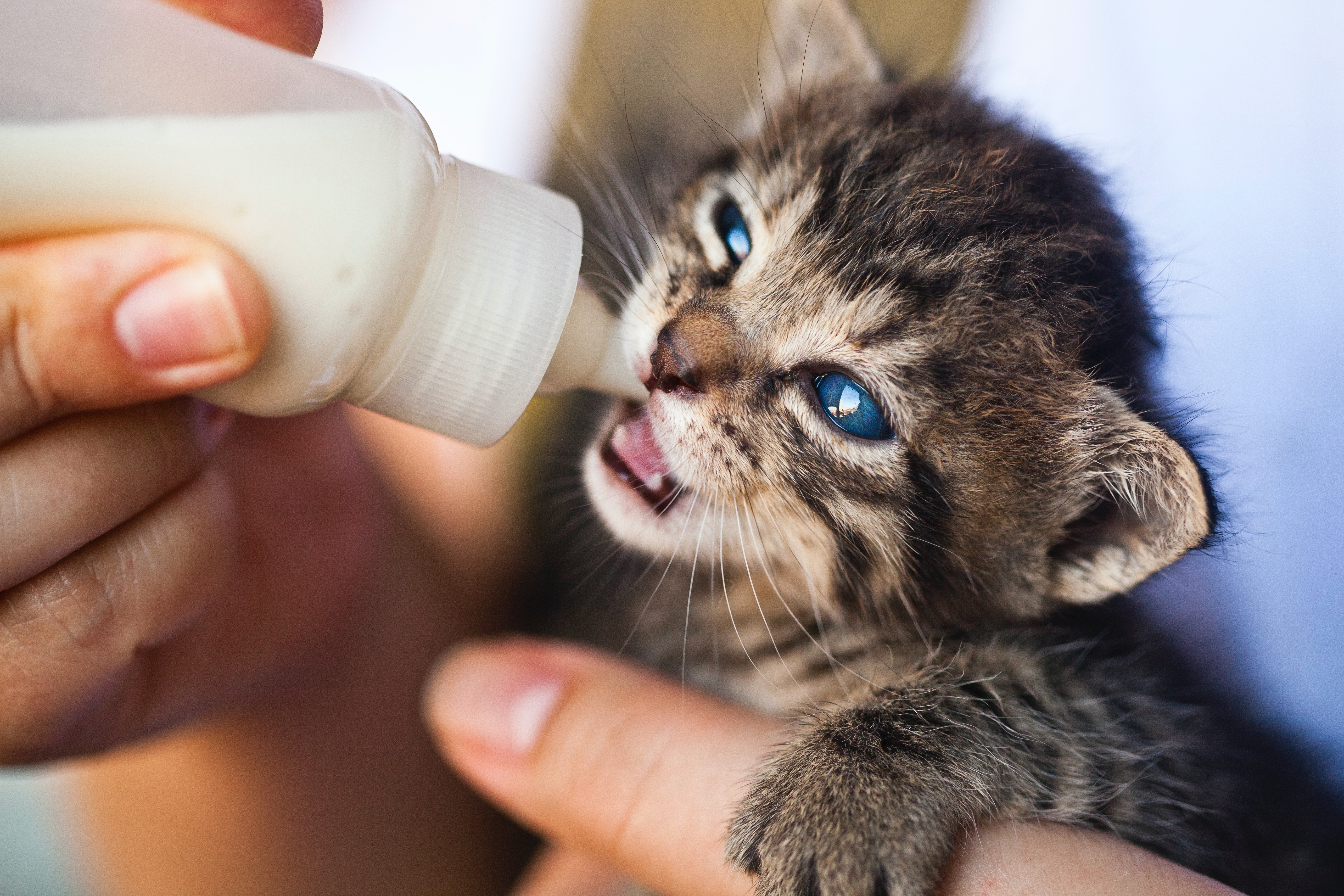
Bottle Babies
Quarantine
Quarantine is defined as a space where your foster animals cannot directly share any air with your resident animals. It should also be a space that is easy to clean should it need sanitizing. Minimal fabric surfaces, washable linens, hiding places blocked off, and a room with a door makes an ideal quarantine space. Not sure if your space qualifies? Ask someone to assess it.
The following must be complete before fosters can meet residents: 2 vaccines, FeLV (FIV) testing, deworming, and ear mite treatment.
All animals entering rescue need to be quarantined for a minimum of 2 weeks even if the above items are done when they enter rescue. This is to ensure the animal does not have a disease that may shed in your home (ringworm, parasites, bacterial or viral illnesses). Quarantine (once complete) does not need to be repeated if they move to a new foster.
Weight Tracking
Bottle babies must be weighed often, at least 3x a day for the first few weeks. Try to weigh them before a feeding, but be consistent since the weight of the formula factors into their total weight. Report weight weekly. Report losses immediately. We have a weight and feeding log here.
Formula Recipe
If using Breeder’s Edge, the ratio is 2T water for 1T powder. For Goatalac, the ratio is 3T of water for 1T of powder.
View chart of amounts here.
Pottying
After each feeding, the kittens must be encouraged and stimulated to pee and poop. This is done by simulating the mother’s wet tongue with a damp rag gently rubbing their genital area until stool/urine come out.
Weaning
When the babies are at least 4 weeks old, you will start weaning them on to solid food. Create a slurry of formula and wet food, using the 3 oz of wet food combined with 1T Breeder’s Edge powder and 2T warm water. Mix powder and water and then mix into kitten wet food. Serve a small portion at a time in multiple bowls. If there is any amount that you do not serve, you can refrigerate and rewarm it for later.
Once they are weaned, kittens should have dry food available at all times as well as fresh water changed at least once a day. Each kitten should be eating one small can of wet food a day as well. If you have a litter of 5, put down 2 cans at a time 3 times a day. Plates should have a bit of food left on them at the end of a meal. If not, add a half can more at each feeding until you have leftovers.
Deworming
Use the protocol above. You can start at 4 weeks if your babies are stable. Pyrantel is safe and mild. Toltrazuril can be harsh so it’s ok to wait on it until after Pyrantel has been completed.
Vaccines
Vaccines can be given at 6 weeks. Repeat every 2 weeks until adopted. There are many people who can vaccinate an animal for you. You can also do it at clinic if you are going for testing anyway.
Microchips
Chips are implanted into every animal. It helps return our fosters to us if they are ever without a home. There are many people who can microchip an animal for you. You can also do it at clinic if you are going for testing anyway.
Testing
Kittens need to be tested for FeLV at 8 weeks old. This can be done at any SOL clinic. You must sign up for it a few weeks in advance here.
Alter
Schedule their alters for 12 weeks old, depending on general growth pattern. Minimum weight is 3lbs. Use the alter scheduling software found here. Alters should be scheduled ASAP. They can always be adjusted if they are ready sooner or later than expected. The same criteria for leaving quarantine apply to going to an alter unless you have been told otherwise for this specific animal by your mentor or leadership. Animals have a high chance of being exposed to others while at the surgery center, so we need to be sure they are protected.
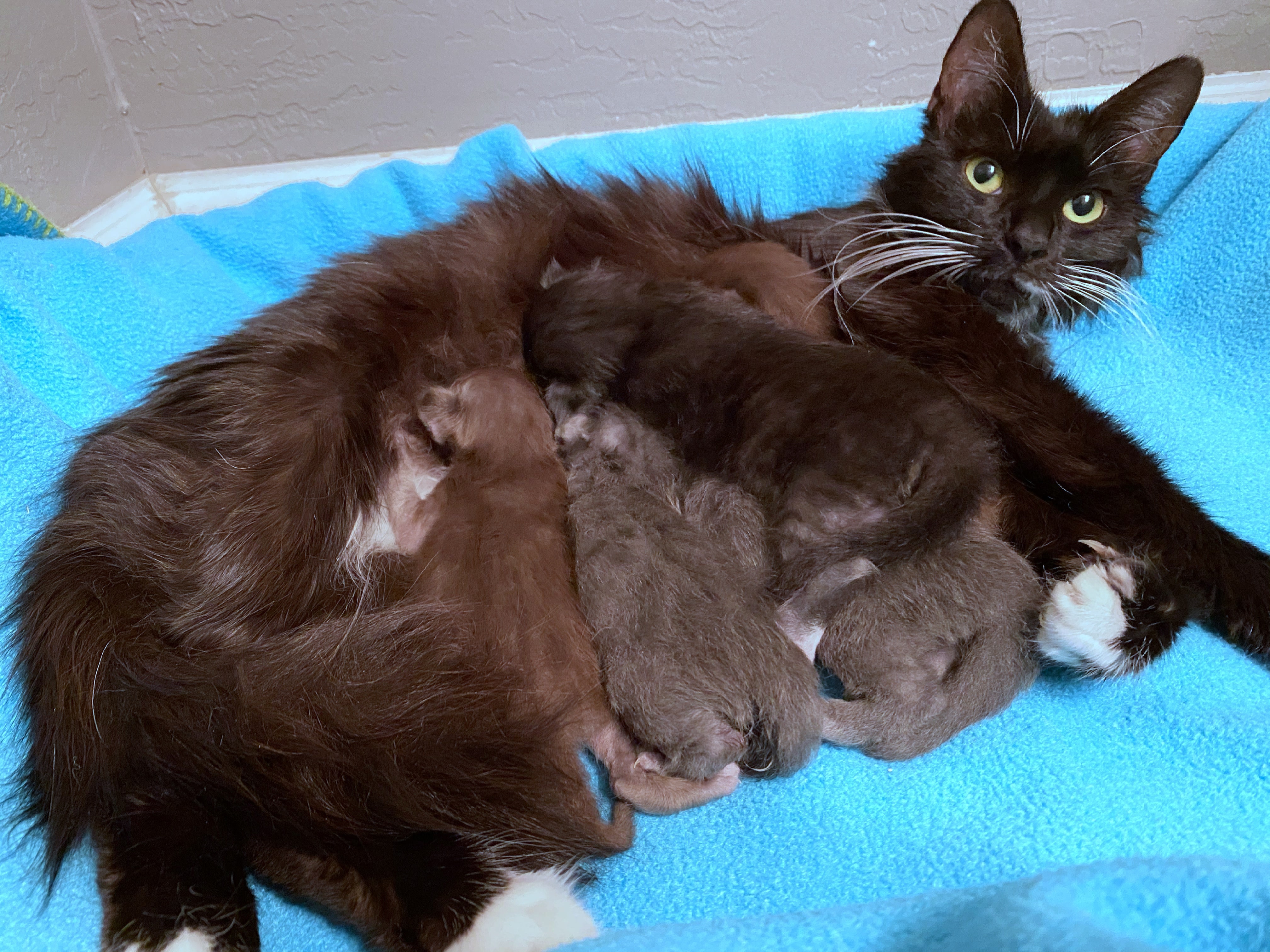
Mama and Babies
Pregnancy
Mama will look very round in the middle and not big elsewhere. Her nipples/teats will be large and pointy with a clear circle of fur missing from around each. In the days before she delivers, she may pass a mucous plug or other discharge and get grumpy (we human mamas get it Mama!). Give her a safe space to queen and only intervene if she needs you. Some mamas want you close (if you’ve bonded with them) and others want privacy. Please talk with those more experienced than you for a list of supplies you will need to have on hand. Ask to be added to the Moms and Babies chat – but this is for tips and tricks only – not medical advice!
Quarantine
Quarantine is defined as a space where your foster animals cannot directly share any air with your resident animals. It should also be a space that is easy to clean should it need sanitizing. Minimal fabric surfaces, washable linens, hiding places blocked off, and a room with a door makes an ideal quarantine space. Not sure if your space qualifies? Ask someone to assess it.
The following must be complete before fosters can meet residents: 2 vaccines, FeLV (FIV) testing, deworming, and ear mite treatment.
All animals entering rescue need to be quarantined for a minimum of 2 weeks even if the above items are done when they enter rescue. This is to ensure the animal does not have a disease that may shed in your home (ringworm, parasites, bacterial or viral illnesses). Quarantine (once complete) does not need to be repeated if they move to a new foster.
Weight Tracking
Babies must be weighed daily. Try to weigh them before a feeding, at approximately the same time each day. Report weight weekly. Report any losses or slow growth immediately.
Formula Recipe
Mama should take care of all of the feeding and pottying. Keep her well-fed using kitten food and lots of wet food. If using Breeder’s Edge, the ratio is 2T water for 1T powder. For Goatalac, the ratio is 3T of water for 1T of powder.
View chart of amounts here. The chart shows total food in a day, so adjust for any nursing Mama is doing.
Weaning
When the babies are at least 4 weeks old, you will start weaning them on to solid food. Create a slurry of formula and wet food, using the 3 oz of wet food combined with 1T Breeder’s Edge powder and 2T warm water. Mix powder and water and then mix into kitten wet food. Serve a small portion at a time in multiple bowls. If there is any amount that you do not serve, you can refrigerate and rewarm it for later. If Mama shows interest in the food, they are more likely to eat it.
Once they are weaned, kittens should have dry food available at all times as well as fresh water changed at least once a day. Each kitten should be eating one small can of wet food a day as well. If you have a litter of 5, put down 2 cans at a time 3 times a day. Plates should have a bit of food left on them at the end of a meal. If not, add a half can more at each feeding until you have leftovers.
Deworming
Use the protocol above. You can start at 4 weeks if your babies are stable. Pyrantel is safe and mild. Toltrazuril can be harsh so it’s ok to wait on it until 7-8 weeks. Do mama and babies at the same time, including the Toltrazuril. Mama does not get Panacur like other adult cats unless she is going to a cafe.
If she is pregnant when she arrives, you can safely do Panacur or Pyrantel if you can complete it before the babies are born.
Microchips
Chips are implanted into every animal. It helps return our fosters to us if they are ever without a home. There are many people who can microchip an animal for you. You can also do it at clinic if you are going for testing anyway.
Vaccines
Vaccines can be given at 6 weeks. Repeat every 2 weeks until adopted. Do mama and babies at the same time. Mama will most likely only need 2 vaccines. There are many people who can vaccinate an animal for you. You can also do it at clinic if you are going for testing anyway.
Testing
Kittens need to be tested for FeLV at 8 weeks old. This can be done at any SOL clinic. You must sign up for it a few weeks in advance here. Mama will be tested for FeLV and FIV at the same time as her babies. She must be at least 30 days out from her last possible exposure to FeLV and FIV.
Alter
Schedule their alters for 12 weeks old, depending on general growth pattern. Minimum weight is 3lbs. Use the alter scheduling software found here. Alters should be scheduled ASAP. They can always be adjusted if they are ready sooner or later than expected. The same criteria for leaving quarantine apply to going to an alter unless you have been told otherwise for this specific animal by your mentor or leadership. Animals have a high chance of being exposed to others while at the surgery center, so we need to be sure they are protected.
Special considerations: Mama must be almost done or done with nursing before alter. DO NOT let the babies nurse once she returns from her alter. Use a shirt on her to physically prevent them from accessing her stomach. NO EXCEPTIONS. The babies can be altered before mama but it’s not common.
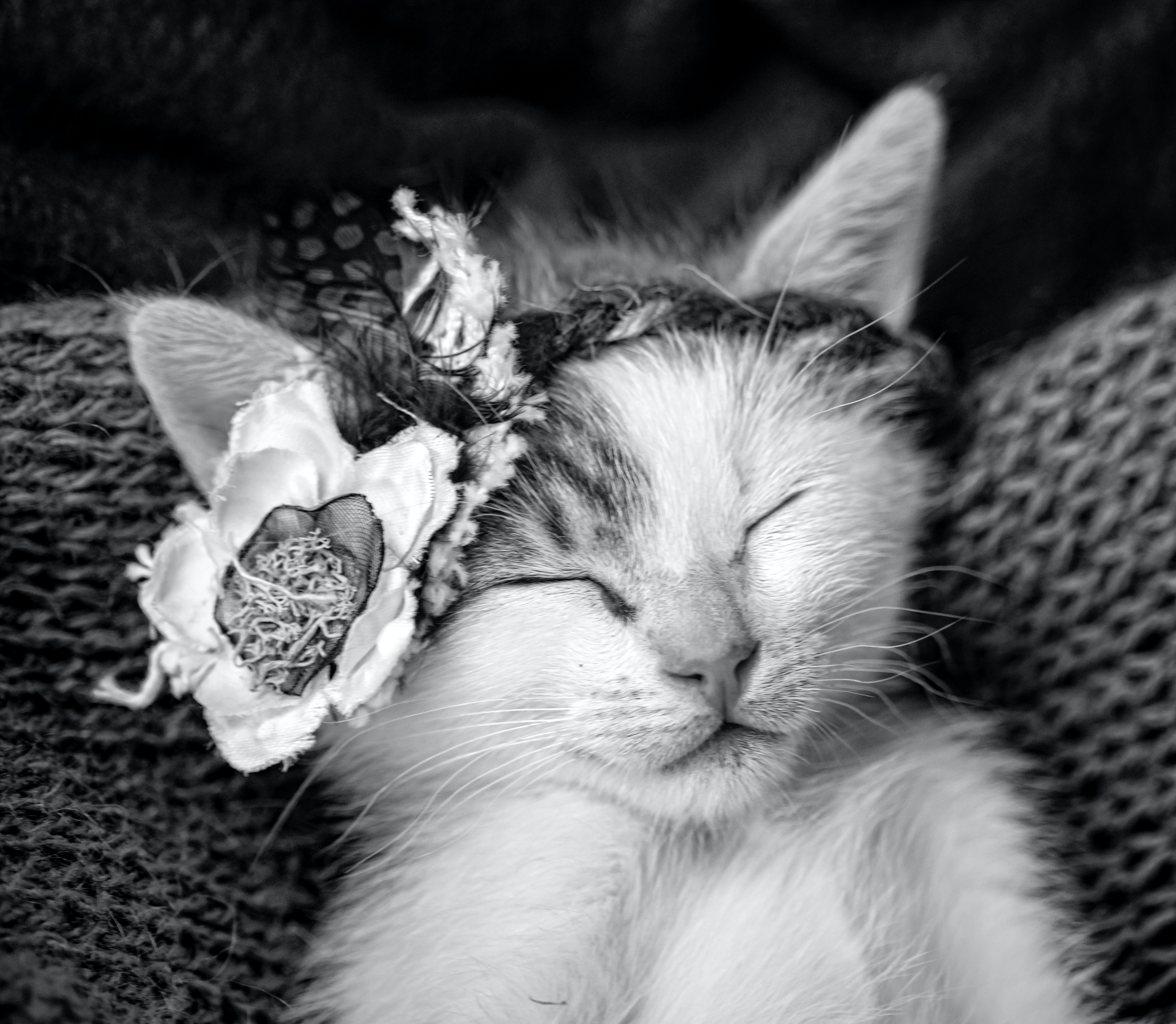
Weaning Age Kittens
Special Considerations
These babies were most likely taken from Mama abruptly. They will need a lot of attention to ensure they transition to solids well. You may need to bottle feed some and others will eat dry food all day long. This is not a one size fits all situation and you need to watch them carefully.
Quarantine
Quarantine is defined as a space where your foster animals cannot directly share any air with your resident animals. It should also be a space that is easy to clean should it need sanitizing. Minimal fabric surfaces, washable linens, hiding places blocked off, and a room with a door makes an ideal quarantine space. Not sure if your space qualifies? Ask someone to assess it.
The following must be complete before fosters can meet residents: 2 vaccines, FeLV (FIV) testing, deworming, and ear mite treatment.
All animals entering rescue need to be quarantined for a minimum of 2 weeks even if the above items are done when they enter rescue. This is to ensure the animal does not have a disease that may shed in your home (ringworm, parasites, bacterial or viral illnesses). Quarantine (once complete) does not need to be repeated if they move to a new foster.
Weight Tracking
Babies must be weighed daily. Try to weigh them before a feeding, but be consistent. Report weight weekly. Report losses or slower growth immediately.
Formula Recipe
If using Breeder’s Edge, the ratio is 2T water for 1T powder. For Goatalac, the ratio is 3T of water for 1T of powder.
View chart of amounts here.
Weaning
When the babies are at least 4 weeks old, you will start weaning them on to solid food. Create a slurry of formula and wet food, using the 3 oz of wet food combined with 1T Breeder’s Edge powder and 2T warm water. Mix powder and water and then mix into kitten wet food. Serve a small portion at a time in multiple bowls. If there is any amount that you do not serve, you can refrigerate and rewarm it for later.
Once they are weaned, kittens should have dry food available at all times as well as fresh water changed at least once a day. Each kitten should be eating one small can of wet food a day as well. If you have a litter of 5, put down 2 cans at a time 3 times a day. Plates should have a bit of food left on them at the end of a meal. If not, add a half can more at each feeding until you have leftovers.
Deworming
Use the protocol above. You can start at 4 weeks if your babies are stable. Pyrantel is safe and mild. Toltrazuril can be harsh so it’s ok to wait on it until after Pyrantel has been completed.
Vaccines
Vaccines can be given at 6 weeks. Repeat every 2 weeks until adopted. There are many people who can vaccinate an animal for you. You can also do it at clinic if you are going for testing anyway.
Microchips
Chips are implanted into every animal. It helps return our fosters to us if they are ever without a home. There are many people who can microchip an animal for you. You can also do it at clinic if you are going for testing anyway.
Testing
Kittens need to be tested for FeLV at 8 weeks old. This can be done at any SOL clinic. You must sign up for it a few weeks in advance here. They must be at least 30 days out from their last possible exposure to FeLV and FIV.
Alter
Schedule their alters for 12 weeks old, depending on general growth pattern. Minimum weight is 3lbs. Use the alter scheduling software found here. Alters should be scheduled ASAP. They can always be adjusted if they are ready sooner or later than expected. The same criteria for leaving quarantine apply to going to an alter unless you have been told otherwise for this specific animal by your mentor or leadership. Animals have a high chance of being exposed to others while at the surgery center, so we need to be sure they are protected.
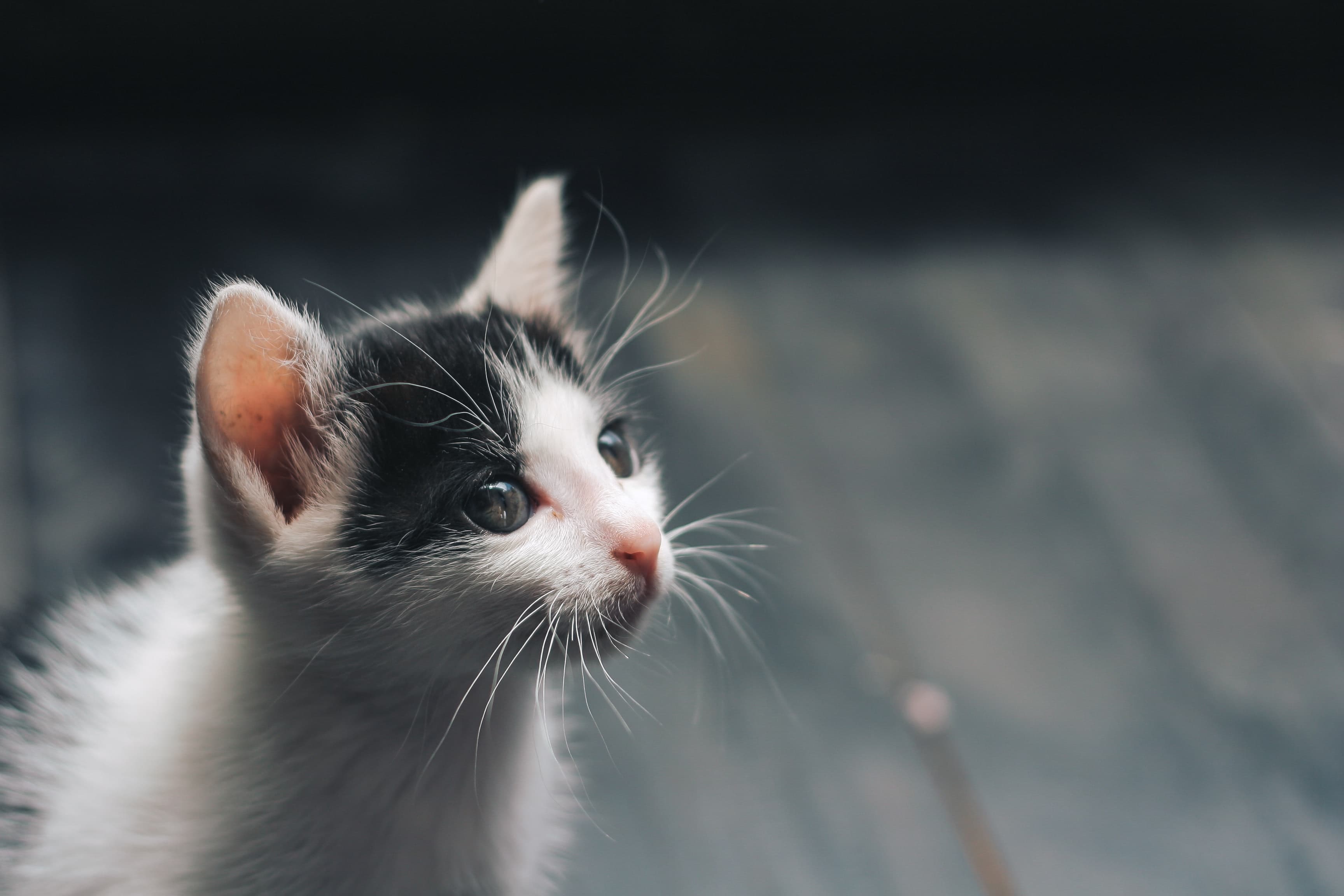
Independent Kittens
Special Considerations
These babies are close to the age of adoption. To give them the best chance at finding a family quickly, they need to be moved through the process ASAP. They may have a 30 day quarantine if they’re coming from outside, but their alter should be within days of their testing date and they should be ready for their forever home about 5 weeks after intake.
Quarantine
Quarantine is defined as a space where your foster animals cannot directly share any air with your resident animals. It should also be a space that is easy to clean should it need sanitizing. Minimal fabric surfaces, washable linens, hiding places blocked off, and a room with a door makes an ideal quarantine space. Not sure if your space qualifies? Ask someone to assess it.
The following must be complete before fosters can meet residents: 2 vaccines, FeLV (FIV) testing, deworming, and ear mite treatment.
All animals entering rescue need to be quarantined for a minimum of 2 weeks even if the above items are done when they enter rescue. This is to ensure the animal does not have a disease that may shed in your home (ringworm, parasites, bacterial or viral illnesses). Quarantine (once complete) does not need to be repeated if they move to a new foster.
Weight Tracking
Kittens must be weighed daily. Try to weigh them before a feeding, at approximately the same time each day. Report weight weekly. Report any losses or slow growth immediately.
Weaning
They should be weaned onto solids, but here is the recipe just in case you need to support a slow growing one. Create a slurry of formula and wet food, using the 3 oz of wet food combined with 1T Breeder’s Edge powder and 2T warm water. Mix powder and water and then mix into kitten wet food. Serve a small portion at a time in multiple bowls. If there is any amount that you do not serve, you can refrigerate and rewarm it for later.
Feeding
Kittens should have dry food available at all times as well as fresh water changed at least once a day. Each kitten should be eating one small can of wet food a day as well. If you have a litter of 5, put down 2 cans at a time 3 times a day. Plates should have a bit of food left on them at the end of a meal. If not, add a half can more at each feeding until you have leftovers.
Deworming
Use the protocol above. You can start as soon as they are taken into rescue. Pyrantel is safe and mild. Toltrazuril can be harsh so it’s ok to wait until the Pyrantel is done.
Microchips
Chips are implanted into every animal. It helps return our fosters to us if they are ever without a home. There are many people who can microchip an animal for you. You can also do it at clinic if you are going for testing anyway.
Vaccines
Vaccines can be given at 6 weeks. Repeat every 2 weeks until adopted. There are many people who can vaccinate an animal for you. You can also do it at clinic if you are going for testing anyway.
Testing
Kittens need to be tested for FeLV when they are at least 8 weeks old. This can be done at any SOL clinic. You must sign up for it a few weeks in advance here. They must be at least 30 days out from their last possible exposure to FeLV and FIV.
Alter
Schedule their alters for 3-5 weeks after intake depending on general growth pattern. They should be at least 12 weeks old. Minimum weight is 3lbs. Use the alter scheduling software found here. Alters should be scheduled ASAP. They can always be adjusted if they are ready sooner or later than expected. The same criteria for leaving quarantine apply to going to an alter unless you have been told otherwise for this specific animal by your mentor or leadership. Animals have a high chance of being exposed to others while at the surgery center, so we need to be sure they are protected.
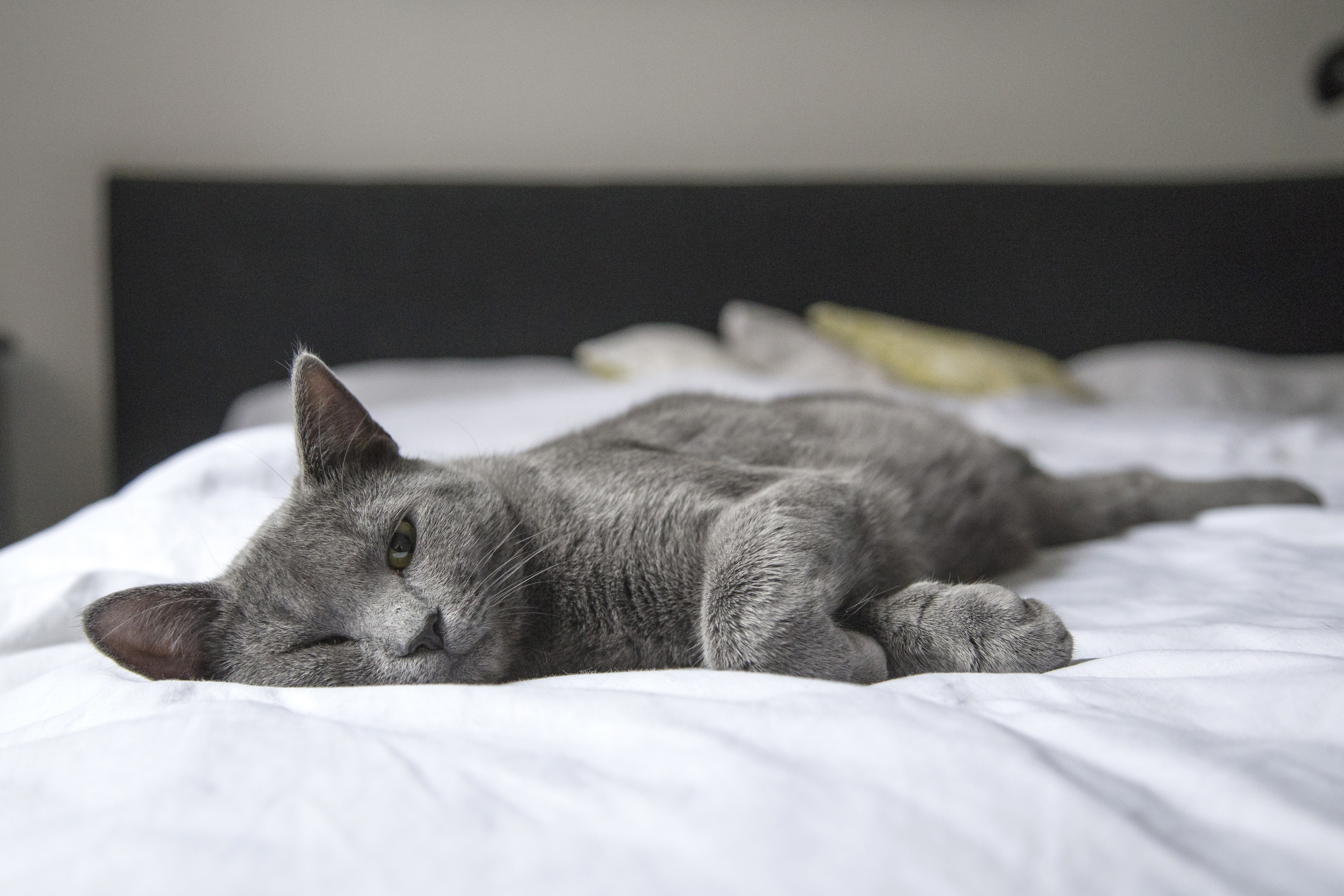
Older Kittens
Special Considerations
These cats are often in rescue for longer than others. They may have medical concerns or may have come into rescue after the ideal socialization age. Your goal is to take them through the process as soon as possible. You will need to coordinate care with leadership, your mentor, and our scheduler.
Quarantine
Quarantine is defined as a space where your foster animals cannot directly share any air with your resident animals. It should also be a space that is easy to clean should it need sanitizing. Minimal fabric surfaces, washable linens, hiding places blocked off, and a room with a door makes an ideal quarantine space. Not sure if your space qualifies? Ask someone to assess it.
The following must be complete before fosters can meet residents: 2 vaccines, FeLV (FIV) testing, deworming, and ear mite treatment.
All animals entering rescue need to be quarantined for a minimum of 2 weeks even if the above items are done when they enter rescue. This is to ensure the animal does not have a disease that may shed in your home (ringworm, parasites, bacterial or viral illnesses). Quarantine (once complete) does not need to be repeated if they move to a new foster.
These kitties often need to hang out with your family after quarantine, so be sure to do a proper introduction to your residents. You want their time with you to be as stress free as possible.
Weight Tracking
If they are ill, they must be weighed daily. If they are being socialized, a couple times a week or as possible is ok. Report weight weekly. Report losses or slower growth immediately.
Feeding
Kittens should have dry food available at all times as well as fresh water changed at least once a day. Each kitten should be eating one small can of wet food a day as well. If you have a litter of 5, put down 2 cans at a time 3 times a day. Plates should have a bit of food left on them at the end of a meal. If not, add a half can more at each feeding until you have leftovers.
Use the good food to help socialize. Only offer it if you are in the room and use it as a reward for pro-social behaviors.
Deworming
Use the protocol above. Some kitties will be on the Pyrantel/Toltrazuril protocol and some will be on Panacur. Read the document carefully and ask questions if you need to.
Vaccines
Vaccines can be given as soon as they are taken into rescue. Repeat in 2-3 weeks. Most of these animals will only need 2 vaccines. There are many people who can vaccinate an animal for you. You can also do it at clinic if you are going for testing anyway.
Microchips
Chips are implanted into every animal. It helps return our fosters to us if they are ever without a home. There are many people who can microchip an animal for you. You can also do it at clinic if you are going for testing anyway.
Testing
Kittens need to be tested for FeLV at 8 weeks old. This can be done at any SOL clinic. You must sign up for it a few weeks in advance here. Animals older than 6 months will also be tested for FIV. They must be at least 30 days out from their last possible exposure to FeLV and FIV.
Alter
If they are not altered, be aware that they can get pregnant or impregnate a sibling at this age.
Schedule their alters for 3-5 weeks after intake depending on general progress through illness or socialization. Minimum needed is 3lbs and 12 weeks old. Use the alter scheduling software found here. Alters should be scheduled ASAP. They can always be adjusted if they are ready sooner or later than expected. The same criteria for leaving quarantine apply to going to an alter unless you have been told otherwise for this specific animal by your mentor or leadership. Animals have a high chance of being exposed to others while at the surgery center, so we need to be sure they are protected.
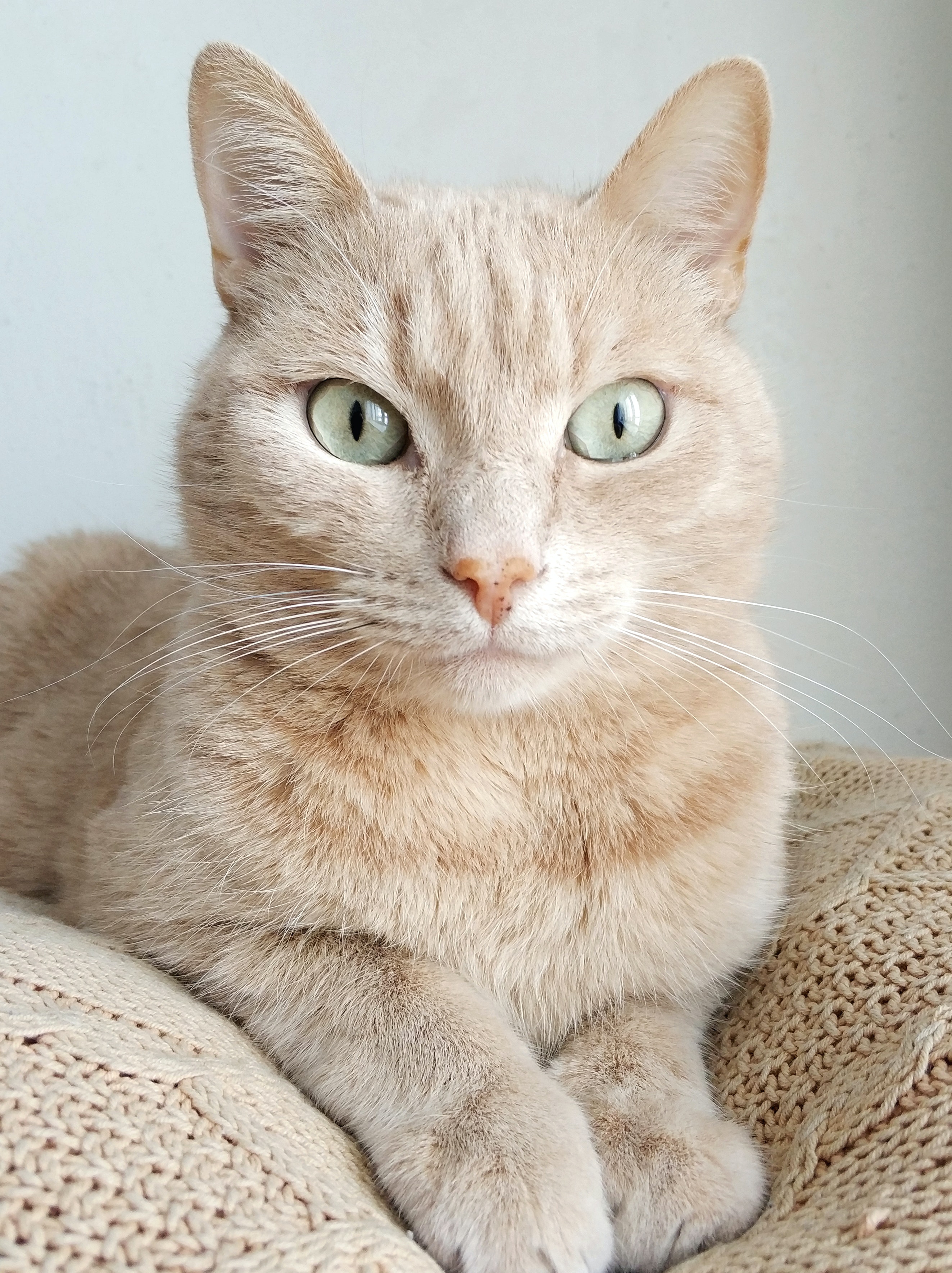
Adult Cats
Special Considerations
These cats are often in rescue for longer than others. They may have medical concerns or may have come into rescue after the ideal socialization age. They may also be owner returns who need some extra love before they find their forever family. Your goal is to take them through the process as soon as possible. You will need to coordinate care with leadership, your mentor, and our scheduler.
Quarantine
Quarantine is defined as a space where your foster animals cannot directly share any air with your resident animals. It should also be a space that is easy to clean should it need sanitizing. Minimal fabric surfaces, washable linens, hiding places blocked off, and a room with a door makes an ideal quarantine space. Not sure if your space qualifies? Ask someone to assess it.
The following must be complete before fosters can meet residents: 2 vaccines, FeLV (FIV) testing, deworming, and ear mite treatment.
All animals entering rescue need to be quarantined for a minimum of 2 weeks even if the above items are done when they enter rescue. This is to ensure the animal does not have a disease that may shed in your home (ringworm, parasites, bacterial or viral illnesses). Quarantine (once complete) does not need to be repeated if they move to a new foster.
These kitties often need to hang out with your family after quarantine, so be sure to do a proper introduction to your residents. You want their time with you to be as stress free as possible.
Weight Tracking
If they are ill, they must be weighed daily. If they are being socialized, a couple times a week or as possible is ok. Report weight weekly. Report losses or slower growth immediately.
Feeding
Adults should have dry food available at all times as well as fresh water changed at least once a day. You can use wet food to help with socializing or to deliver medicine but it should be seen as a treat not a regular meal unless you’re told otherwise.
Deworming
Use the protocol above. You can start as soon as they are taken into rescue. These animals will get Panacur only unless there is an issue.
Microchips
Chips are implanted into every animal. It helps return our fosters to us if they are ever without a home. There are many people who can microchip an animal for you. You can also do it at clinic if you are going for testing anyway.
Vaccines
Vaccines can be given as soon as they are taken into rescue. Repeat in 2-3 weeks. Most of these animals will only need 2 vaccines. Older adults will only need one. There are many people who can vaccinate an animal for you. You can also do it at clinic if you are going for testing anyway.
Testing
All adults will be tested for FeLV and FIV. This can be done at any SOL clinic. You must sign up for it a few weeks in advance here.
Alter
If they are not altered, be aware that they can get pregnant or impregnate a sibling at this age.
Schedule their alters for 3-5 weeks after intake depending on general progress through illness or socialization. Use the alter scheduling software found here. Alters should be scheduled ASAP. They can always be adjusted if they are ready sooner or later than expected. The same criteria for leaving quarantine apply to going to an alter unless you have been told otherwise for this specific animal by your mentor or leadership. Animals have a high chance of being exposed to others while at the surgery center, so we need to be sure they are protected.
